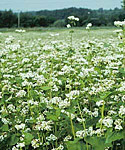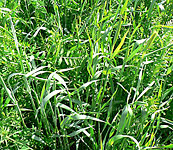 |
 Cover cropping increases fertility in soil by increasing the biological life and diversity. It aids in moisture control, weed suppression and prevention of wind erosion, while turning nutrients back into the soil. Cover cropping increases fertility in soil by increasing the biological life and diversity. It aids in moisture control, weed suppression and prevention of wind erosion, while turning nutrients back into the soil.
The farm usually uses a rye/vetch mix that has the advantages of both a grass (rye) and a legume (vetch).  The vetch contains the nitrogen-fixing bacteria in its root nodules. They grow deep to bring up nutrient resources unavailable to shallower-rooted crops. Rye captures N from the air and fixes it in the green portion of the plant. It can grow even with a snow cover and prevents the spread of any winter-hardy weeds. Rye also gives vetch a structure to climb on. The combination of rye and vetch acts to improve the soil in a natural and organic way. Peas, clover and buckwheat are other important cover crops. The vetch contains the nitrogen-fixing bacteria in its root nodules. They grow deep to bring up nutrient resources unavailable to shallower-rooted crops. Rye captures N from the air and fixes it in the green portion of the plant. It can grow even with a snow cover and prevents the spread of any winter-hardy weeds. Rye also gives vetch a structure to climb on. The combination of rye and vetch acts to improve the soil in a natural and organic way. Peas, clover and buckwheat are other important cover crops.
Cover crops are turned under using harrows and disks when they are about a foot tall. They are not plowed. This creates a lighter fluffier soil, better able to hold air and water. The active biology of the soil eats up the cover crop in a couple of weeks and the field is ready to plant with the next crop. |





